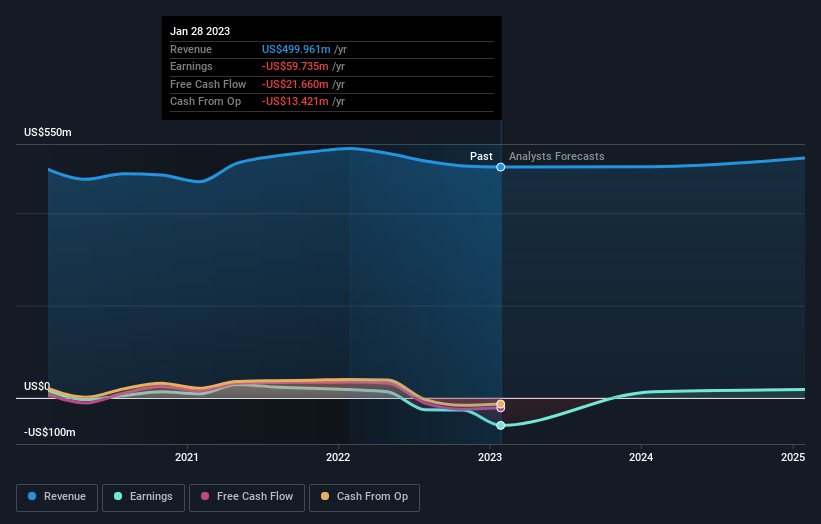Recent uptick might appease Vera Bradley, Inc. (NASDAQ:VRA) institutional owners after losing 16% over the past year
Key Insights
Significantly high institutional ownership implies Vera Bradley's stock price is sensitive to their trading actions
The top 12 shareholders own 51% of the company
If you want to know who really controls Vera Bradley, Inc. (NASDAQ:VRA), then you'll have to look at the makeup of its share registry. The group holding the most number of shares in the company, around 43% to be precise, is institutions. That is, the group stands to benefit the most if the stock rises (or lose the most if there is a downturn).
Institutional investors would appreciate the 12% increase in share prices last week, given their one-year returns have been disappointing at 16%.
Let's take a closer look to see what the different types of shareholders can tell us about Vera Bradley.
Check out our latest analysis for Vera Bradley
What Does The Institutional Ownership Tell Us About Vera Bradley?
Many institutions measure their performance against an index that approximates the local market. So they usually pay more attention to companies that are included in major indices.
As you can see, institutional investors have a fair amount of stake in Vera Bradley. This suggests some credibility amongst professional investors. But we can't rely on that fact alone since institutions make bad investments sometimes, just like everyone does. It is not uncommon to see a big share price drop if two large institutional investors try to sell out of a stock at the same time. So it is worth checking the past earnings trajectory of Vera Bradley, (below). Of course, keep in mind that there are other factors to consider, too.
Our data indicates that hedge funds own 8.4% of Vera Bradley. That's interesting, because hedge funds can be quite active and activist. Many look for medium term catalysts that will drive the share price higher. Because actions speak louder than words, we consider it a good sign when insiders own a significant stake in a company. In Vera Bradley's case, its Top Key Executive, Patricia Miller, is the largest shareholder, holding 9.5% of shares outstanding. For context, the second largest shareholder holds about 8.7% of the shares outstanding, followed by an ownership of 8.4% by the third-largest shareholder. Interestingly, the second-largest shareholder, Barbara Baekgaard is also Top Key Executive, again, pointing towards strong insider ownership amongst the company's top shareholders.
Looking at the shareholder registry, we can see that 51% of the ownership is controlled by the top 12 shareholders, meaning that no single shareholder has a majority interest in the ownership.
While studying institutional ownership for a company can add value to your research, it is also a good practice to research analyst recommendations to get a deeper understand of a stock's expected performance. There is some analyst coverage of the stock, but it could still become more well known, with time.
Insider Ownership Of Vera Bradley
While the precise definition of an insider can be subjective, almost everyone considers board members to be insiders. Management ultimately answers to the board. However, it is not uncommon for managers to be executive board members, especially if they are a founder or the CEO.
I generally consider insider ownership to be a good thing. However, on some occasions it makes it more difficult for other shareholders to hold the board accountable for decisions.
Our information suggests that insiders maintain a significant holding in Vera Bradley, Inc.. It has a market capitalization of just US$161m, and insiders have US$42m worth of shares in their own names. It is great to see insiders so invested in the business. It might be worth checking if those insiders have been buying recently.
General Public Ownership
With a 22% ownership, the general public, mostly comprising of individual investors, have some degree of sway over Vera Bradley. This size of ownership, while considerable, may not be enough to change company policy if the decision is not in sync with other large shareholders.
Next Steps:
It's always worth thinking about the different groups who own shares in a company. But to understand Vera Bradley better, we need to consider many other factors.
I always like to check for a history of revenue growth. You can too, by accessing this free chart of historic revenue and earnings in this detailed graph.
If you are like me, you may want to think about whether this company will grow or shrink. Luckily, you can check this free report showing analyst forecasts for its future.
NB: Figures in this article are calculated using data from the last twelve months, which refer to the 12-month period ending on the last date of the month the financial statement is dated. This may not be consistent with full year annual report figures.
Have feedback on this article? Concerned about the content? Get in touch with us directly. Alternatively, email editorial-team (at) simplywallst.com.
This article by Simply Wall St is general in nature. We provide commentary based on historical data and analyst forecasts only using an unbiased methodology and our articles are not intended to be financial advice. It does not constitute a recommendation to buy or sell any stock, and does not take account of your objectives, or your financial situation. We aim to bring you long-term focused analysis driven by fundamental data. Note that our analysis may not factor in the latest price-sensitive company announcements or qualitative material. Simply Wall St has no position in any stocks mentioned.
Join A Paid User Research Session
You’ll receive a US$30 Amazon Gift card for 1 hour of your time while helping us build better investing tools for the individual investors like yourself. Sign up here


